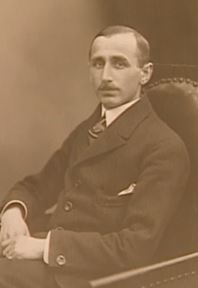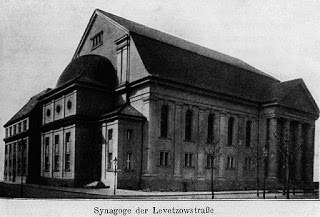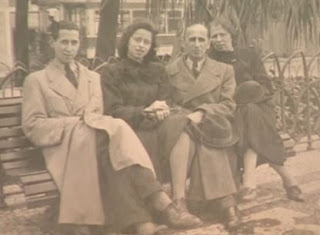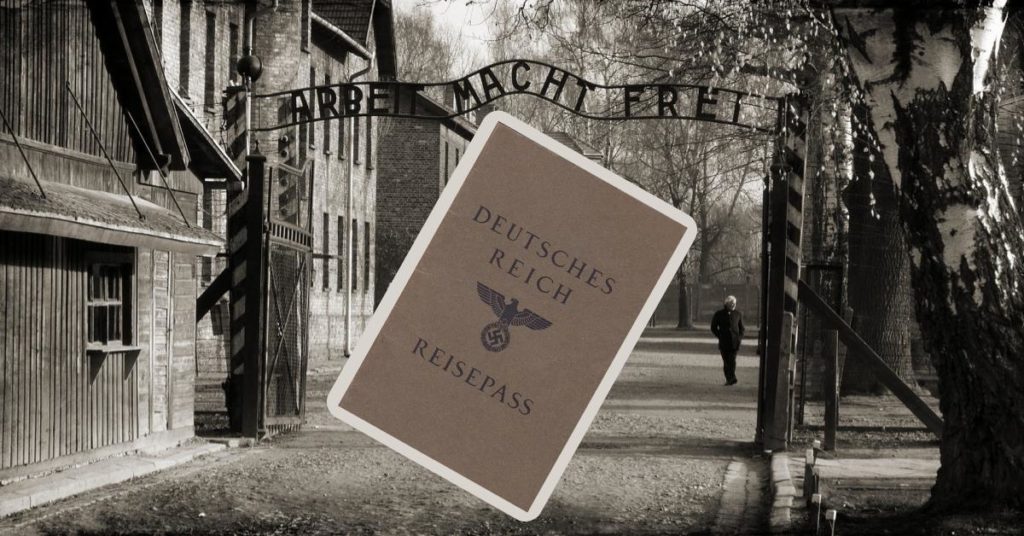I may have tracked down another one of Ziebell’s black market passport clients – Alfred Gutmann. The 1939 German Minority Census on Mapping the Lives has only one Alfred Gutmann living in Berlin at the time. While I am not 100% sure that it is him, I thought that I would dig a bit deeper, just in case it was him.
The German Minority Census gives one piece of hopeful information, Alfred and his family, wife Lina and children Herbert James and Steffi Mirjam, all escaped to the USA via Portugal. Whether false Finnish passports helped them is doubtful. On top of that, Alfred’s son, Herbert James Goodman (anglicized version of Gutmann), gave an interview on 17 October 1996 that was filmed for the Visual History Foundation (Survivors of the Shoah). I was able to watch the video and learned quite a bit about the Gutmann family. Supplemented by information from Ancestry, I think we can get a fairly good picture of the family. Again, I am not 100% sure that this is the correct Alfred Gutmann but… the likelihood seems fairly high.

(From USC Shoah Foundation site)
For those arriving on this site, a few background blogs might be helpful. I suggest reading the one on Algoth Niska as well as these two: Characters Involved in the Passport Scheme and Overview of the Black Market Passport Scheme. Suffice to say, in 1937/1938, German lawyer Jürgen Ziebell told desperate Jews that, for a price, he could get them authentic foreign naturalizations, passports and visas so that they could escape Nazi Germany. In September 1938, he met Algoth Niska who was looking to unload some more forged Finnish passports. Ziebell arranged passports for eight of his clients:
- Dorothea Klara Schachtel
- Alfred Gutmann
- Erna Levi
- Richard Eduard Wiener
- Louis Georg & Viktoria Gertrud Hagen
- Ernst Michel David & Clara David
Before the holders of the passports could try to use them, the entire black market passport scheme was rolled up the authorities who, in October 1938, arrested anyone and everyone associated with it, including several of the eight. Let’s see what we can learn about the Alfred Gutmann, born 1885, who escaped to the USA. The following is based on genealogical records and the interview of Herbert James on the USC Shoah Foundation site. James Gutmann/Goodman does not specifically mention Ziebell or the Finnish passport business.
Early Life
Alfred Gutmann was born 27 April 1885 in Berlin to parents Max Meier Gutmann and Rosalie Ehrlich. Max and Rosalie had seven children in total: Clara (1876), Hermann (1881), Alfred (1885), Selma (1888), Elsa (1891), Thekla (1894) and Louie (1896). Thekla passed away shortly after she was born, leaving six children to survive into adulthood. All but one of them would escape the Shoah.
Alfred fought in the German Imperial Army through the First World War, along with his brothers, Hermann and Louie. After the war, on 15 April 1920, Alfred married Lina Schternsohn (Sternsohn). At the time Alfred was living at Immanuelkirchstrasse 9, just south of Prenzlauer Berg and gave his occupation as Kaufmann (businessman). His son later said that his father manufactured men’s shirts.
Starting a Family

Alfred and Lina had two children, Herbert James, born 1921 and Steffi Mirjam born in 1924. According to James, his family was a conservative Jewish family who observed all of the Jewish feasts and attended the synagogue on Fridays and sometimes Saturdays. James celebrated his Bar Mitzvah in the synagogue in the Levetzowstrasse when he was 13 years old (1934).
James wanted to become a manufacturer of merchandise like his father but the situation in Germany under the Nazis grew progressively worse.
In 1934/1935, Alfred started running into problems with his business and the Nazis. Alfred had served in the Kaiser’s army in the First World War, and James believed that was one of the reasons why they were able to survive a bit longer in Berlin than anyone else.
Rising Fear in Nazi Germany
With the worsening situation, James’s parents suggested that he learn a trade, because with a trade, one could always find work. James’s chose to become an electrician and was apprenticed to a Jewish electrical contractor (Elektro Sand). Eventually, the Jewish owner (Wilhelm Sand) of the business had to give it up and it was taken over by a non-Jew (Heinrich Hahne).
On the evening of Kristallnacht (9/10 November 1938), Alfred and his son went into hiding for a few days with one of Alfred’s business acquaintances (likely a non-Jew). Alfred’s wife and daughter stayed at home because there was talk that the Nazis wouldn’t touch women and children. Later on, they found out that wasn’t always the case.
A few months before Kristallnacht, in September 1938, Alfred tried to arrange for a Finnish passport for himself through Ziebell. Perhaps he thought that if he could reach Finland, he could bring the rest of his family with him. But the arrests of Ziebell’s group by the Gestapo put an end to that idea.
In 1939, the family was living at 30/31 Grolmanstraße in Berlin-Charlottenburg, just north of the intersection of Uhland Straße and Kurfurstendamm.
As the war progressed (1939 and 1940) word filtered back from the Eastern Front of what was happening to the Polish and Russian Jews under the Nazis. Jews in Germany were advised to get out if they could. Alfred tried to get James and Steffi out first, to Australia, New Zealand or England, but it was impossible. Some of the countries required a lot of money and the Gutmann family didn’t have that kind of money.
Seeking to Escape Nazi Germany
Eventually Lina tracked down a cousin (Sidney A. Meren) in the United States and asked him to sponsor them to immigrate to the United States. The cousin went to quite a bit of effort to give an affidavit and send supporting documentation to the US Consulate in Berlin. The Gutmann family was approved for American visas but then needed to obtain additional documentation from the German police. The papers issued by the German police were only good for four weeks and after that the consulate would not issue the visas.

left to right – Herbert James, Steffi Mirjam, Alfred and Lina
(From USC Shoah Foundation site)
At that point (1940), the only way out was via the Siberian express to Yokohama but by the time everything was arranged, the visa itself had expired. Shortly after that, the Siberian route was also closed off.
The family, including the cousin in America, had to start all over again in gathering together all of their documentation. They also needed to gather together $400 to cover their passage and, with the help of Alfred’s sister and brother in the US, they were able to achieve that.
Finally, the family was granted a US visa in 1941 and, on 25 February, travelled by rail from Berlin to Paris to Spain and then on to Lisbon from whence they were scheduled to catch a ship to America. The family could only take 10 German Marks, about $6US/person (1996 dollars). The trip took six days and the family had to wait 10 to 12 days for the next ship which sailed on 15 March 1941 from Lisbon. Finally, on 30 March 1941, the Gutmann family arrived in the US aboard the S.S. Serpa Pinto.
On the passenger manifest, Alfred gave his sister’s name, Else Gutmann of Kantstrasse 52, as his contact in Berlin and the name of his wife’s first cousin, Sidney A. Meren, as his contact in the United States. James mentioned in his interview that Alfred’s two brothers, Hermann and Louie had immigrated to Australia in the mid-1930s and manufactured men’s ties. As it turns out, Louie had made his way the US and was there to greet his brother and family when they arrived.
Alfred’s Siblings
I searched for Elsa and am sad to report that she was deported to Litzmannstadt (Łódź) Ghetto on 24 October 1941. The following year, on 4 May 1942, she was deported to Kulmhof (Chelmno) Extermination Camp where she likely perished.
As for Alfred’s other siblings, Clara/Klara (née Gutmann) Danziger had immigrated to the USA in 1938 with her husband. As noted above, Hermann Gutmann had immigrated to Australia. Selma (née Gutmann) Spitz immigrated to the USA in 1939. Why the final sibling, Elsa, stayed behind is a mystery, and a tragic one. Perhaps there were no other long-established relatives in America who could sponsor her.
Life in the USA
Alfred Gutmann was naturalized in the US in 1947 in Philadelphia and worked as a wholesale salesman of women’s apparel. He passed away in Philadelphia on 28 May 1963 at the age of 78 years. His wife, Lina, passed away in 1971. James Goodman passed away in 2008 and, as of 2018, Steffi Goodman, was still alive.
Through much adversity, Alfred persisted and managed to extract his family out of Nazi Germany at the eleventh hour. Half a year after their escape via Lisbon, Alfred’s sister was deported from Berlin to the Łódź Ghetto. Had the family stayed any longer, it is likely that they would have faced the same fate.
Sources
Ancestry – genealogy records
USC Shoah Foundation – Herbert James Gutmann/Goodman interview
